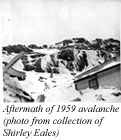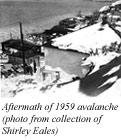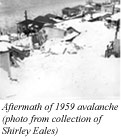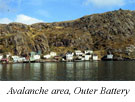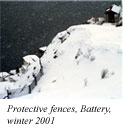Date: February 16, 1959
Location: The Battery, St. John’s
Easting: 372750
Northing: 5269600
Latitude: 47° 34′ 00″ N
Longitude: 52° 41′ 00″ W
Fatalities: 5
Injuries: 9+
Source: Daily News
A ferocious storm hit St. John’s on the night of the 16th of February, with winds reported up to 135 mph, dumping 22″ of snow. At 1:05 am, residents in the Outer Battery heard a sound described as louder than a clap of thunder. An avalanche struck two houses sweeping them down-slope and into the rear of two other houses. The two houses, belonging to the families of Clarence Wells, and Jim Piercey, contained 14 people. Clarence Wells was the nephew of Alfred Wells, whose family was hit by the 1921 avalanche. The top story of the Piercey house was ripped off, and the Wells house completely demolished.
Rescuers were on the scene almost immediately, and worked furiously over the next 12 hours despite appalling weather conditions. Over 50 Battery residents, co-ordinated by the efforts of local resident Raymond Riche, dug through the debris, and quickly rescued Clarence Wells, his wife and child, and three children of the Piercey family. One of the three Piercey children (a 2 year old girl) was swept 200′ down-slope and was rescued by Ralph Barnes who had heard the noise of the avalanche, and saw her through his window, almost completely buried on a fish flake. After two hours of digging, Ruth Wells (16) was discovered, trapped under a stove, and badly burnt. Over the next few hours the searchers uncovered the bodies of Mr. and Mrs. Piercey, and Mrs. Vincent, Jim Piercey’s mother, and rescued Isiah Dawe (living in the Wells house), who had attained the age of 100 a few months before. Gloria Piercey and Mrs Vincent had been sharing the same bed, but Gloria was thrown clear, whereas Mrs. Vincent was buried and suffocated. Mr. Dawe later died in hospital, reportedly of shock. Still missing was Shirley Noseworthy, a 16 year old friend of Ruth Wells, and Ted Wells, the 19 year old son of Clarence Wells. Ruth and Shirley had been skating at Memorial Stadium when the storm hit, and had made it back to the Battery.
It was Shirley Noseworthy’s first visit to the Battery, and she did not return until 35 years later, as part of a television programme marking the anniversary of the avalanche. 10 hours after the avalanche, rescuers heard the cries of Shirley, responding to the sounds of their efforts. She was pulled from the debris, showing remarkable courage throughout. She was badly frost-bitten on her right leg, but after 3 weeks of hospital treatment recovered fully. After 12 hours, the body of Ted Wells was recovered, and taken to Devon House along with the other victims.
Margeret Wells contacted us after seeing a newspaper article on avalanches in Newfoundland. She described her experience as “a night of horror”. Her house stood adjacent to the Piercey and Wells houses completely destroyed, and when the avalanche struck, snow stove in the window at the rear of the house, filling the kitchen with snow. The telephone and electrical lines were still functioning but the police and other authorities were unable to get to the Battery. Mrs. Wells had three children and was pregnant with her fourth. She had to walk to safety through deep snow and in appalling weather, with the considerable help of friends and neighbours. She was reluctant to return to the house later that year, but had little choice, as no alternative housing was available.
Elsewhere in the Outer Battery, 11 members of the Garland family had gathered in the house of the senior Garland for shelter. The house was buried by what was apparently an earlier avalanche, and they were trapped until dug out by rescuers. Fortunately the house was able to withstand the weight of snow, and no injuries occurred. The residents of the Outer Battery were evacuated during the day, and were found temporary housing by the Red Cross. At the time there was a belief amongst the residents that this would be a permanent move. A Battery resident, interviewed by the Evening Telegram said “This place may become a ghost town now. It appears to be the end of the Outer Battery for winter living.” Another interviewee commented “My wife tells me we won’t be living here anymore”. However Raymond Riche, the hero of the rescue attempts, firmly stated that people would move back, because, as fishermen, this was their place of work. In follow-up stories in the Evening Telegram, Alex Wells, whose house lay below the Piercey’s, was interviewed. He is quoted as saying “What a night… we were frightened… all of us were…. about what had happened…. and we didn’t know what else would happen… never again please…”. The Telegram also devoted an editorial column to the disaster, suggesting that preventative steps needed to be taken.
“Many people are beginning to have some second thoughts on the appalling prospect of half a dozen people being killed and their homes destroyed by an avalanche almost in the centre of the capital city of this province. They have a right to wonder what steps will be taken to prevent a recurrence of such a tragedy“.
Evening Telegram editorial, 26th February, 1959.

